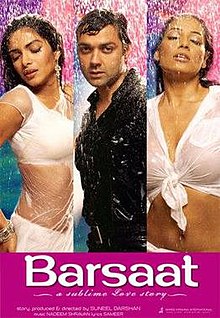Video Song
A music video or song video is a short film integrating a song and imagery, produced for promotional or artistic purposes.[1] Modern music videos are primarily made and used as a marketing device intended to promote the sale of music recordings. Although the origins of music videos date back much further, they came into prominence in the 1980s, when MTV based their format around the medium. Prior to the 1980s, these works were described by various terms including "illustrated song", "filmed insert", "promotional (promo) film", "promotional clip", "song video", "song clip" or "film clip".
Music videos use a wide range of styles of film making techniques, including animation, live action filming, documentaries, and non-narrative approaches such as abstract film. Some music videos blend different styles, such as animation and live action. Many music videos interpret images and scenes from the song's lyrics, while others take a more thematic approach. Other music videos may be without a set concept, being merely a filmed version of the song's live performance.[2]
In 1926, with the arrival of "talkies" many musical short films were produced. Vitaphone shorts (produced by Warner Bros.) featured many bands, vocalists and dancers. Spooney Melodies in 1930 was the first true musical video series.[citation needed] Shorts were typically six minutes in duration, and featured Art Deco-style animations and backgrounds combined with film of the performer singing.
Animation artist Max Fleischer introduced a series of sing-along short cartoons called Screen Songs, which invited audiences to sing along to popular songs by "following the bouncing ball", which is similar to a modern karaoke machine. The sing along concept is still used today, especially with younger audiences such as High School Musical. Early 1930s cartoons featured popular musicians performing their hit songs on-camera in live-action segments during the cartoons. The early animated films by Walt Disney, such as the Silly Symphonies shorts and especially Fantasia, which featured several interpretations of classical pieces, were built around music. The Warner Brothers cartoons, even today billed as Looney Tunes and Merrie Melodies, were initially fashioned around specific songs from upcoming Warner Brothers musical films. Warner Brothers also produced the cartoon "Three Pigs in a Polka", set to Johannes Brahms' Hungarian Dances. This film actually included many elements to the Walt Disney version of the Three Little Pigs, such as the pigs playing a violin and a piccolo. Live action musical shorts, featuring such popular performers as Cab Calloway, were also distributed to theaters.
Blues singer Bessie Smith appeared in a two-reel short film called St. Louis Blues (1929) featuring a dramatized performance of the hit song. Numerous other musicians appeared in short musical subjects during this period. Later, in the mid-1940s, musician Louis Jordan made short films for his songs, some of which were spliced together into a feature film Lookout Sister. These films were, according to music historian Donald Clarke, the "ancestors" of music video.[4]
A music video or song video is a short film integrating a song and imagery, produced for promotional or artistic purposes.[1] Modern music videos are primarily made and used as a marketing device intended to promote the sale of music recordings. Although the origins of music videos date back much further, they came into prominence in the 1980s, when MTV based their format around the medium. Prior to the 1980s, these works were described by various terms including "illustrated song", "filmed insert", "promotional (promo) film", "promotional clip", "song video", "song clip" or "film clip".
Music videos use a wide range of styles of film making techniques, including animation, live action filming, documentaries, and non-narrative approaches such as abstract film. Some music videos blend different styles, such as animation and live action. Many music videos interpret images and scenes from the song's lyrics, while others take a more thematic approach. Other music videos may be without a set concept, being merely a filmed version of the song's live performance.[2]
In 1926, with the arrival of "talkies" many musical short films were produced. Vitaphone shorts (produced by Warner Bros.) featured many bands, vocalists and dancers. Spooney Melodies in 1930 was the first true musical video series.[citation needed] Shorts were typically six minutes in duration, and featured Art Deco-style animations and backgrounds combined with film of the performer singing.
Animation artist Max Fleischer introduced a series of sing-along short cartoons called Screen Songs, which invited audiences to sing along to popular songs by "following the bouncing ball", which is similar to a modern karaoke machine. The sing along concept is still used today, especially with younger audiences such as High School Musical. Early 1930s cartoons featured popular musicians performing their hit songs on-camera in live-action segments during the cartoons. The early animated films by Walt Disney, such as the Silly Symphonies shorts and especially Fantasia, which featured several interpretations of classical pieces, were built around music. The Warner Brothers cartoons, even today billed as Looney Tunes and Merrie Melodies, were initially fashioned around specific songs from upcoming Warner Brothers musical films. Warner Brothers also produced the cartoon "Three Pigs in a Polka", set to Johannes Brahms' Hungarian Dances. This film actually included many elements to the Walt Disney version of the Three Little Pigs, such as the pigs playing a violin and a piccolo. Live action musical shorts, featuring such popular performers as Cab Calloway, were also distributed to theaters.
Blues singer Bessie Smith appeared in a two-reel short film called St. Louis Blues (1929) featuring a dramatized performance of the hit song. Numerous other musicians appeared in short musical subjects during this period. Later, in the mid-1940s, musician Louis Jordan made short films for his songs, some of which were spliced together into a feature film Lookout Sister. These films were, according to music historian Donald Clarke, the "ancestors" of music video.[4]
Video Song
Video Song
Video Song
Video Song
Video Song
Video Song
Video Song
Video Song
Video Song
Video Song
Video Song
Video Song




















No comments:
Post a Comment